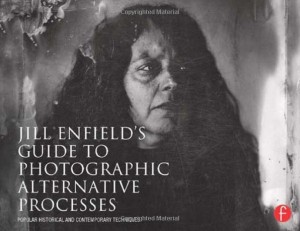 The fact that there are 13 chapters in her new book, Jill Enfield’s Guide to Photographic
The fact that there are 13 chapters in her new book, Jill Enfield’s Guide to Photographic
Alternative Processes (Focal Press 2014), isn’t any kind of negative omen for readers of this
extremely informative book.
It’s more about your good fortune in finding this book. Enfield does her usual best effort of
explaining processes in a thoughtful, careful manner. She assembled this book in the same
manner and care in which she produces her impeccable pictures. She is a craftsperson
who leaves no stone unturned in her effort to enable us (the reader) to understand better those process that have been around since the inception of this wonderful art form we call photography.
Among the chapter listings are: Safety and Chemicals, A Guide to Materials and Techniques,
The Digital Negative Process, Fugitive and Not-So-Fugitive Printing, Cyanotypes, Salt and Albumen Prints, Van Dyke Brown, Kallitype, and Argyrotype Prints, Platinum and Palladium Prints, Wet Plate Collodion, Liquid Emulsion Prints, Gum Printing, Transfers, Multiple Printing and Other Techniques, Ceramics and Photography.
As you can see, if you choose to follow the path of alternative photography, you could do no better than to purchase this book and add it your library. For teachers and students alike this guide is crammed full of technical advice, personal observations, chemical use hand-holding, and a virtual treasure trove of practical advice, with plenty of historical references.
On the very first page of text, Enfield sets the stage perfectly. She tells us how she uses every tool
available to achieve the results she has envisioned for each and every process.
“When I wrote my first book in 2002, digital photography was still in its infancy,” she writes.
“Photography was all about the darkroom and few people were saying digital would be taking over. Then schools started to tear down their darkrooms making way for digital ‘darkrooms.’ Old-timers were saying ‘This is it—the end of the wet darkroom is here!’ Just like in the 1800s when photography was introduced to the public, painters were saying it was the end. But what has happened, both then and now, is that artists have adopted new ways of working so that old techniques could be folded into the new ones. I have included some wonderful work that brings together every tool by combining inkjet prints with alternative processes as well as striking montages.”
Even though she includes many recipes, with highly detailed information, she encourages artists to follow their own path and create recipes of their own by discovery and practice. There are many wonderful examples of work by noted artists: Quinn Jacobsen, Dan Burkholder, France
Scully Osterman, Diana Bloomfield, Joni Sternbach, Louviere + Vanessa, Martha Casanave, Mark Nelson, Luther Gerlach and many others.
With more than 30-years in the chemical-solutions trenches Jill Enfield is more than qualified to take
you by the hand and guide you through each process in her book. She teaches, guides, and informs you enough, without having to even be an expert in Photoshop, to enable you to produce images of which you can be proud.
Jill Enfield’s Guide to Photographic Alternative Processes
Views: 1605
